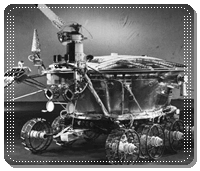
When the Moon race, as started by the USA by May 1961, began, the Soviets, with their space chief-engineer Korolyov, the father to the Sputnik, put their hopes into a new, more powerful launcher, the N1 but, too, into a concept of mobile, lunar rover remotely-commanded from the Earth and of a permanent lunar base. The mobile rover was named the 'Lunokhod'. Its construction was entrusted to the Transmash tank factory in Leningrad, under the direction of engineer Alexander Kemurdzhian. The project was classified state secrecy as he was later transfered to the NPO Lavochine Institute in Moscow, which was dedicated to the construction of spacecraft
 | a view of a Soviet Lunokhod lunar rover. picture site 'Amateur Astronomy' |
As Korolyov had died in 1966, the project however passed to a phase when rovers pilots were chosen. They were from the Red Army. As Americains were making great strides with the Apollo program and that the N1 launcher did not, Soviet Luna missions managed to land on Moon in 1968. They took pictures and tested the lunar soil. The design of the Lunokhod, on the other hand, had become definitive. The rover was featuring motor wheels instead of tred-belts like previously envisioned. A cover, when deployed, served like a solar panel with its interior, and when closed like a protection against the cold of Moon's night. A polonium-powered device procured energy and heat to the rover. A Lunokhod had a archaic aspect, like a large bucket moving on wheels. A Lunokhod weighed 378 lbs and had dimensions of 7 by 4 ft. The Soviets eventually decided to take a form a advantage as the USA were moving closer to a first Moon human landing. They took the decision to launch their Lunokhod by early 1969. On February 19th, a Proton rocket tookoff from the Baikonur Cosmodrome, carrying the rover. The rocket unluckily exploded in flight as the Soviets thus had no answer to the success the Americains met in July of that same year, with Neil Armstrong walking on the Moon
It was not before November 10th 1970 that the Soviets could launch a second rover. The Lunokhod was attached to a Luna craft and was again launched by a Proton. The mission was a success that time and it reached the lunar orbit after a 4½ days journey. It remained in lunar orbit 2 more days before successfully landing on Moon, in the Sea of Showers, by November 17th. The Lunokhod hence was taken in charge by its pilots, who were working from Simferopol, in Crimea, Russia. A pilot, which was remotely controlling the rover through a joystick, had its work hindered however by the fact that cameras had been attached too low on the chassis and as he used a TV picture which transmitted line by line and which remained 10 second on screen only. The Lunokhod worked with a spectrometer and numerous other science instruments. He could travel at two speeds, one of half a mile per hour, the other of 1.2 mile per hour. It was moving by daytime and parked at night. As it primary mission was scheduled to last 90 days, the Lunokhod spent 11 months on the Moon, journeying through 7 miles and hibernating during the lunar night. The rover twice nearly missed to be lost due to a pilotage error. That mission provided for data about regolith and close ups of local topography
Russians used a Lunokhod then in January 1973 as the rover, attached to the Luna 21 and embarking French science experiments, successfully landed East of the Sea of Serenity by the Le Monnier crater. He journeyed 23 miles on the Moon during 4 months as it sported higher resolution cameras and an improved scientific payload. The success of the mission was ensured by many tests, largely the ones held in the fall of 1972 as some faulty long-range radio communications systems were timely corrected. The remote control system had some trouble during the 250th session, when the order to stop had to be issued three times before Lunokhod-2, heading toward a crater, complied. The Lunokhod-2 moved faster than the first craft. Both Lunokhod used laser retroreflector in communication and navigation, a method unusual at the time. Unfortunately, the mission was brought to an early end due to overheating, perhaps when soil got on the rover and covered key components. The spacecraft's internal temperature rose to about 109 degrees Fahrenheit and it stopped responding. Such Lunokhod missions allowed, in some sense, that the USSR could save the face. Albeit no Russian cosmonaut could walk on Moon, both Lunokhods were a form a Soviet success in terms of technology. The Russians really had a advance in term of robotic exploration of the Moon and the solar system planets. They then kept building and researching 'planetokhods' until by USSR fall. The Lunokhod-3, a even faster robot, was built in late 1970s but the mission never occurred because of insufficient funding. Like for the Sputnik project, all the Lunokhod team was shrouded into the Soviet state secrecy, of them Babakin, the project's other engineer. When the USSR came to its end, the Lunokhod engineers were allowed to a collaboration with their US counterparts in the JPL as those tested the 'Marsokhod' they had built. The US space scientists took advantage of such knowledge. The US Martian Pathfinder rover, by 1996 and then the current Spirit and Opportunity are largely building upon the Soviet technology and technical solutions
Website Manager: G. Guichard, site 'Amateur Astronomy,' http://stars5.6te.net. Page Editor: G. Guichard. last edited: 1/17/2018. contact us at ggwebsites@outlook.com